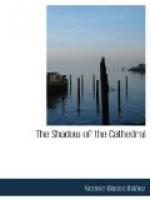He continued looking at the little door with melancholy eyes as though he were ready to weep over the decay of music.
“In there, Gabriel, are many beautiful works, that ought not to be forgotten as long as art lives in the world. In profane music we have not been great, but believe me that Spain has been far otherwise with religious authors. That is, provided that profane music and religious music really exist, which I doubt; for me there is only—music—and I think he will be a clever man who draws the line where one ends and where the other begins. Behind this wall of Saint Christopher’s, the works of all the great Spanish musicians sleep, mutilated and covered with dust. Perhaps it is better they do sleep, when you hear what is sung in this choir! Here you will find Christobal Morales, who three hundred years ago was Chapel-master here, and began the reform of music twenty years before Palestrina. In Rome he shares the glory with the famous master; his portrait is in the Vatican, and his lamentations, his motets, and his Magnificat rest here, forgotten for centuries. And Victoria? Do you know him? Another of the same period; his jealous contemporaries called him ‘Palestrina’s monkey’ taking all his works to be imitations, in consequence of his long sojourn in Rome; but, believe me, instead of being plagiarisms from the Italian, they are far superior. Here also is Rivera, a Toledan master who no one remembers, but in the archives there is a whole volume of his masses, and Romero de Avila, who more than anyone had studied the Muzarabe chants, and Ramos de Pareja, not the least musician of the fifteenth century, who wrote in Bologna his book ’De Musica Tractatus,’ and destroyed the ancient system of Guido de Arezzo, discovering the tonality of sound; and the Monk Urena, who added the note ‘si’ to the scale, and Javier Garcia, who in the last century reformed music, leading it towards Italy (God forgive him!), a beaten track from which we have not yet emerged; and Nebra, the great organist of Carlos III., who, a century before Wagner was born, used musical discords. When he wrote the Requiem for the funeral of Dona Barbara di Braganza, foreseeing the surprise and difficulties that the musicians and singers would meet with in the innovations in his score, he wrote on the margin, ’This is to give notice that there are no mistakes in the score.’ His Litany became so celebrated that it was forbidden to copy it, under pain of excommunication; but I think to-day the persons who remember it would be the excommunicated. Believe me, Gabriel, these archives are a pantheon of great men, but a pantheon, unluckily, from which no one emerges.”
Then he added, lowering his voice:




